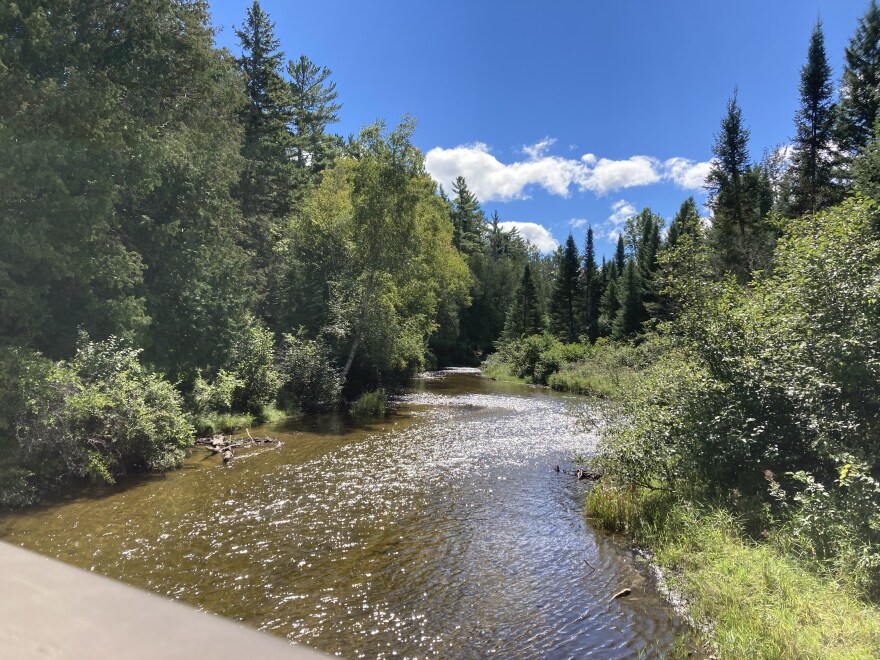On a dirt road seven miles east of Wolverine, biologists from the US Fish and Wildlife Service have set up a temporary base on the Pigeon River.
Over the last few days, they’ve been pumping a bright orange pesticide called TFM into the river and following the chemical as it travels downstream, toward Mullet Lake.
The pesticide mainly targets lampreys, and its use in rivers all around the state is part of a 70-year program to prevent sea lampreys from taking over the Great Lakes.
“This is a pretty standard application set up we’ll have in the river at any given point,” said Chris Eilers, a biologist with the US Fish and Wildlife Service. “Usually we’ll have people go, ‘oh, what’s going on here,’ and we’ll have to explain that we’re doing a lampricide application and the water’s safe.”
Eilers is supervising the team of 17 biologists applying and monitoring the TFM lampricide.
“If we stopped this program tomorrow, within three years, we would see massive changes to our ecology,” he said. “You would not see anywhere near the same numbers of steelhead, chinook salmon, coho salmon, or lake trout.”
At each site, biologists sample the water traveling from other application sites. The river dilutes the TFM as it travels downstream, so they test to see how much pesticide is in the water and add more accordingly.
In Michigan, there are hundreds of invasive species, ranging from fish and plants to parasites and insects. Each is unique, but overall, they pose a threat to Michigan’s economy, environment, and human health.
Joanne Foreman is with the Michigan Department of Natural Resources. She said management is a constant balancing act between protecting ecosystems and eliminating specific species - without having unintended consequences.
Climate change adds even more pressure, both in raising the need to protect our resources and in increasing the challenges to doing so.
“Everybody can unwillingly be a pathway to bring an invader, so people knowing that they're part of the prevention group is very important,” Foreman said.
The state typically sets aside $9 million dollars annually to research, prevent, detect, and eliminate invasive species.
Unlike sea lampreys, most invasive species don’t have a special pesticide or convenient cure - and once they enter a system, complete eradication is rare. This means that prevention and public awareness is the best strategy for management. Despite the challenges, Foreman said she believes the work is worth it.
“[Invasive species management] has saved millions and millions of dollars that can't be really calculated,” Foreman said. “If you think about a world where nobody had done anything, you would shudder to think about all the different consequences. Yes, I do continue to believe this work is really crucial.”

On the Pigeon River, Chris Eilers said sea lamprey numbers have declined in the Great Lakes, but we’ll likely never get rid of them entirely.
“I think it’s just a part of realism that you have to accept and know what we’re doing is good enough,” Eilers said. “We’re doing a great job out there, we’re taking care of a lot of lamprey. To strive for perfection is not beneficial.”
Though it seems like a never-ending stalemate, Eilers said it’s rewarding to see the results of his team’s work.
“You know how awesome that is? That is really cool,” he said. “I did that, Lauren did that, Adam did that. We’re a team, and you guys should be proud of every lamprey you kill.”
After Eilers and his team finish their application, they’ll pack up and move on to their last stop along the Pigeon River.
Within a day, any traces of the lampricide in the water will be gone. But give it a few years, and they’ll be back to do it all over again, just to keep the sea lampreys at bay.
Correction Oct. 14: Joanne Foreman is with the Michigan Department of Natural Resources. In the original version of this story, she was incorrectly titled as working with the Michigan Department of Environment, Great Lakes, and Energy.


